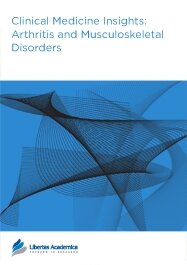

Publication Date: 24 May 2010
Type: Original Research
Journal: Clinical Medicine Insights: Arthritis and Musculoskeletal Disorders
Citation: Clinical Medicine: Arthritis and Musculoskeletal Disorders 2010:3 33-42
doi: 10.4137/CMAMD.S4827

Abstract
Background: Early definitive diagnosis and effective treatment are mandatory in rheumatoid arthritis (RA) as it can halt the disease progression and subsequent joints destruction.
Objective: To investigate the diagnostic and prognostic value of anti-mutated citrullinated vimentin (anti-MCV) and its correlation with disease activity, peripheral and axial skeleton affection in RA patients.
Patients and methods: A total of 123 patients with different rheumatic diseases were enrolled in a prospective-two year study at Ain Shams University hospital: 64 patients with RA and 59 patients with other rheumatic diseases as controls. RA patients were fulfilling the traditional and the new ACR/EULAR diagnostic criteria for RA. They have been followed up for two years. At baseline, all RA patients were subjected to: Clinical assessment of disease activity by taking full histories, general and local examination, measurement of 28 joint count of tender and swollen joints with calculation of disease activity score (DAS-28) for each patient. Complete blood count, erythrocytes sedimentation rate, C-reactive protein and rheumatoid factor titers were performed. Anti-MCV IgG immunoglobulins’ assay was performed at the study endpoint by ELISA. RA patients were then classified into; anti-MCV positive and anti-MCV negative groups for statistical comparison. Plain X-ray was performed on the peripheral joints and scored by the Simple Erosion Narrowing score (SEN-score). Magnetic Resonance Imaging (MRI) scans were carried out to 22 RA patients on cervical and lumbosacral regions.
Results: Anti-MCV antibodies were found to be of high sensitivity (79.6%) and specificity (96.6%) in diagnosing RA. The area under the curve was 0.893 at 95% confidence interval (CI), confers an odds ratio of 23.5. Anti-MCV positive RA patients had significantly higher DAS-28 and SEN-scores than anti-MCV negative patients; who were found to have more benign disease with lower incidence of erosions (P , 0.05). MRI scans revealed that; 17/22 (77%) had cervical joints involvement while, 8 (36%) had lumbo-sacral joint lesions (P , 0.05), both were correlated significantly with aggressive peripheral joint disease.
Conclusion: Anti-MCV antibodies are promising diagnostic and prognostic marker in RA, with high sensitivity and specificity. They may identify a subset of RA patients with aggressive early erosive disease. The axial skeleton—especially the cervical spine—could be affected in RA and this was correlated with aggressive peripheral joints’ disease. MRI scanning is a sensitive method for detecting axial skeleton involvement in RA, in attempt for better disease control and outcomes.
PDF (1.16 MB PDF FORMAT)
RIS citation (ENDNOTE, REFERENCE MANAGER, PROCITE, REFWORKS)
BibTex citation (BIBDESK, LATEX)
XML
PMC HTML

The staff of Libertas Academica have been exceptionally easy to work with. They continually keep authors updated and are responsive to all requests. They were also very flexible to work with when I had some challenges from my end as an author. Article reviews were received very promptly and were constructive and helpful for improving the manuscript. The online submission system was easy to use and provided clear guidance on what was needed. I highly ...
Facebook Google+ Twitter
Pinterest Tumblr YouTube